| Author |
Message |
Jean Thibodeau

|
 Posted: Tue 28 Oct, 2014 6:57 pm Post subject: Making it in Bronze: Tod Stuff. Posted: Tue 28 Oct, 2014 6:57 pm Post subject: Making it in Bronze: Tod Stuff. |
 |
|
I'm having a wooden model for a walking stick head made in bronze, I just sent the wooden sculpt to Tod of Tod's Stuff to make the necessary moulds and made an initial order of 6 units.
http://www.todsstuff.co.uk/todsfoundry/index.htm
| Quote: | Tod's Foundry can also supply custom items to your specification and design.
|
Tod's Stuff has a subdivision called Tod's Foundry and I got in touch with him to get a quote on the project.
I think that using his foundry service could be very useful for people wanting to make DIY projects where parts like pommels, guards or other things can be made.
He does bronze and he can also do cast steel but the price on steel is higher, and there is a minimum order of 20 units in steel.
With bronze the minimum order is 3.
The reason for the minimums I thinks because any lesser numbers wouldn't be cost effective and the actual foundry that produces the castings have these minimums numbers for the casting tree to cast all the 3 or 20 pieces in one pour.
Doing one pour for one piece might be possible but would probably cost as much for the setup as doing the full number of castings.
The socket hole is square and defined by the layers of wood puzzle piece creating the negative space.
Tod might be able to confirm some of the details that I'm inferring from the information he gave me, or correcrt any mistakes I may be making about the process..
Tod does the preparation needed to produce a master mould and individual, I assume wax reproductions, for each of the cast pieces.
When I get the castings back I will put some of them together as walking sticks and I will then update my Walking stick " Topic.
For now I will add below a few concept drawings, and some in progress pics of the sculpting and the final shape of the model I sent to Tod.
 Attachment: 129.48 KB Attachment: 129.48 KB
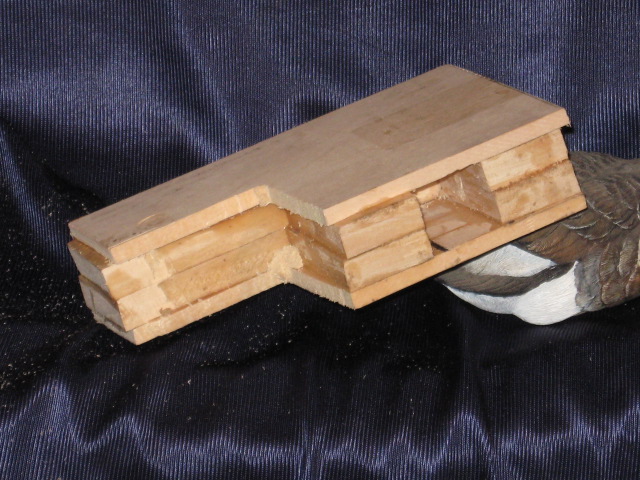
The basic shape assembled with the wood grain at 90° to each other in different layers.
 Attachment: 127.19 KB Attachment: 127.19 KB
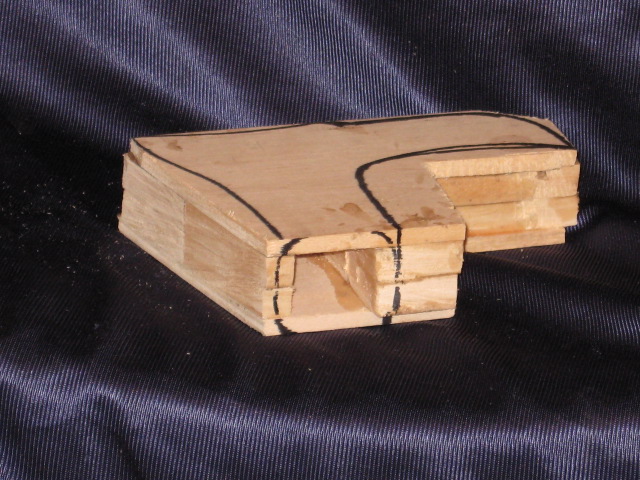
The rough outline drawn on the sides and some wood trimmed off.
 Attachment: 137.29 KB Attachment: 137.29 KB
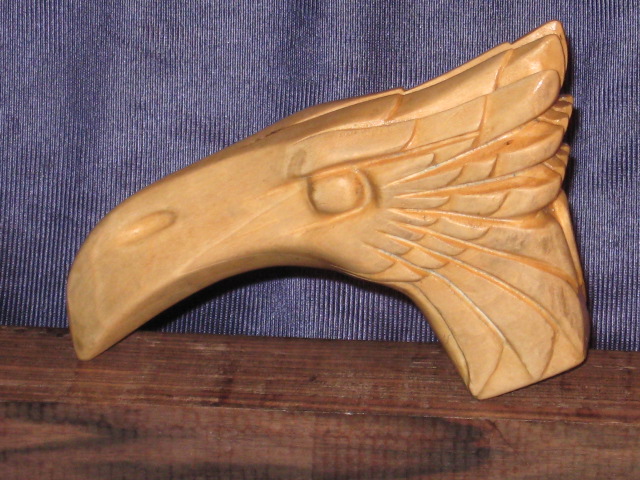
The finished sculpt side view.
 Attachment: 144.06 KB Attachment: 144.06 KB
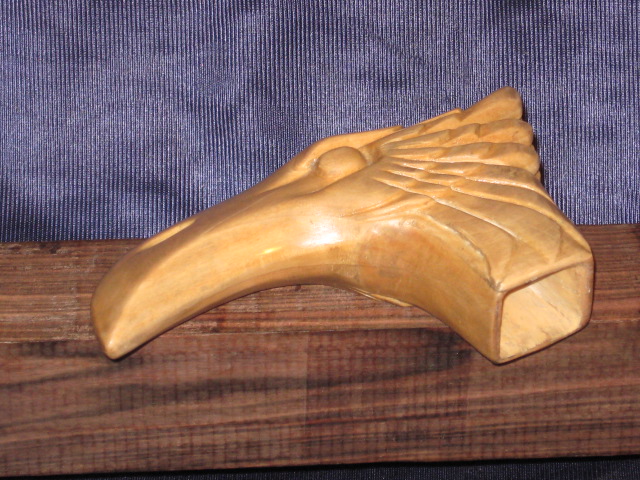
Angled pic showing the square socket hole.
 Attachment: 83.07 KB Attachment: 83.07 KB
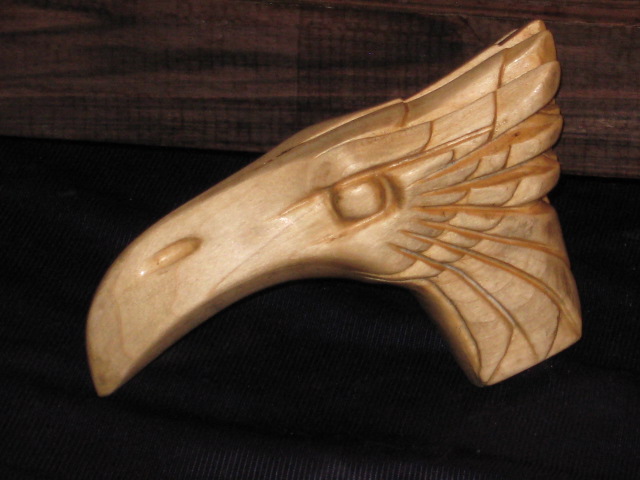
Another side pic, better lighting I think.
 Attachment: 134.46 KB Attachment: 134.46 KB
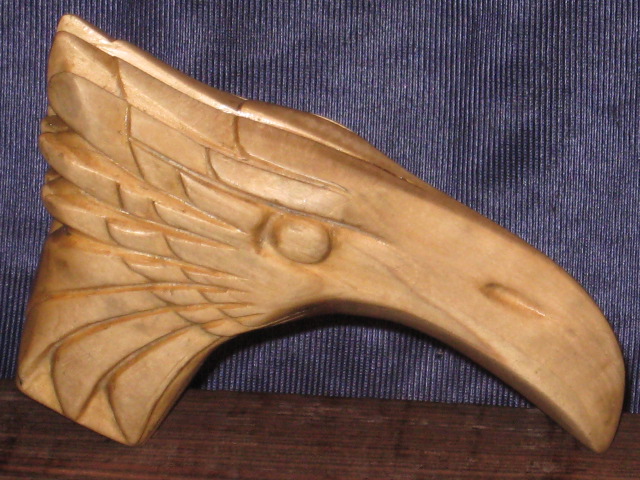
The other side of the head.
 Attachment: 123.4 KB Attachment: 123.4 KB
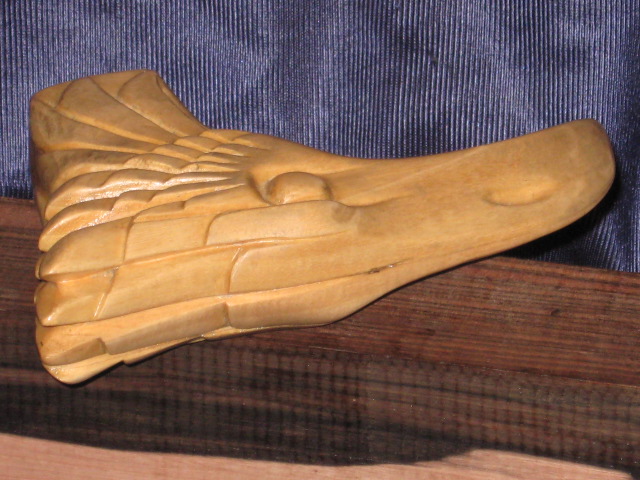
Top at an angle.
 Attachment: 129.66 KB Attachment: 129.66 KB
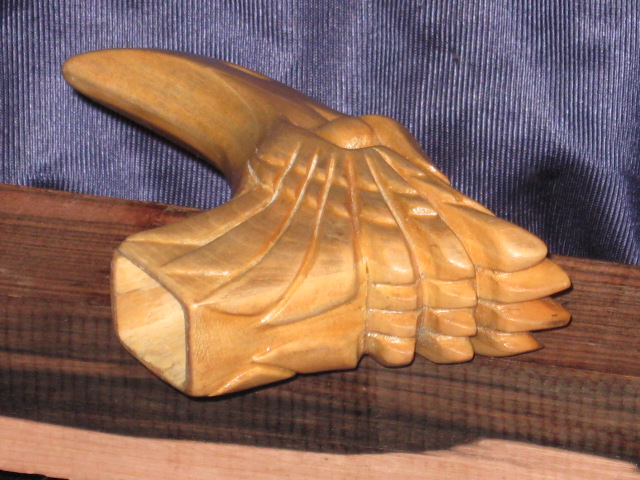
Back side of head.
 Attachment: 68.93 KB Attachment: 68.93 KB
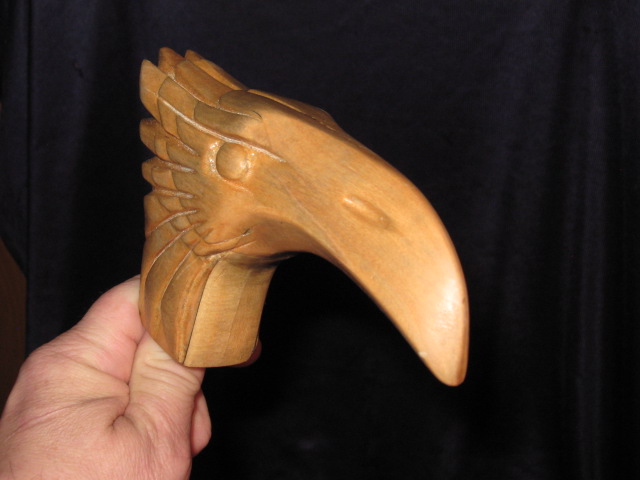
In hand to show scale.
You can easily give up your freedom. You have to fight hard to get it back!
|
|
  |
 |
|
Ken Speed
|
 Posted: Wed 29 Oct, 2014 3:33 am Post subject: Posted: Wed 29 Oct, 2014 3:33 am Post subject: |
 |
|
Jean,
This is interesting and exciting! I hope Tod has some time to share some of the process with us. Great carving!
|
|
  |
 |
Aaron Hoard

|
 Posted: Wed 29 Oct, 2014 6:19 am Post subject: Posted: Wed 29 Oct, 2014 6:19 am Post subject: |
 |
|
|
That is going to look great in bronze. (it already looks great in wood!)
|
|
  |
 |
Jean Thibodeau

|
 Posted: Wed 29 Oct, 2014 8:31 pm Post subject: Posted: Wed 29 Oct, 2014 8:31 pm Post subject: |
 |
|
Oh, just noticed that I forgot to include the early concept drawing I made before sculpting it in wood.
The finished sculpt is slightly different than any of the drawings, but things change when one is working in 3D rather than imagining 3D in a drawing.
You can scroll up to compare the drawings to the finished piece.
 Attachment: 78.75 KB Attachment: 78.75 KB
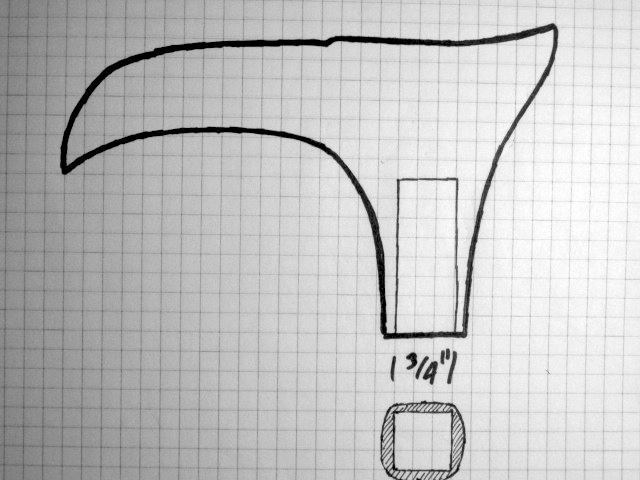
 Attachment: 86.08 KB Attachment: 86.08 KB
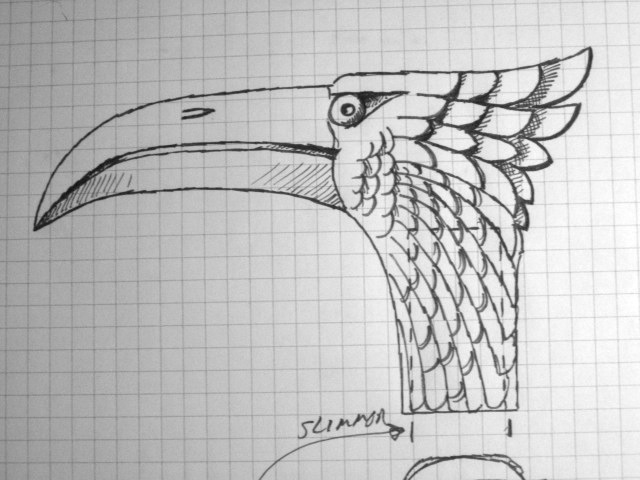
 Attachment: 99.82 KB Attachment: 99.82 KB

 Attachment: 83.42 KB Attachment: 83.42 KB

 Attachment: 100.03 KB Attachment: 100.03 KB
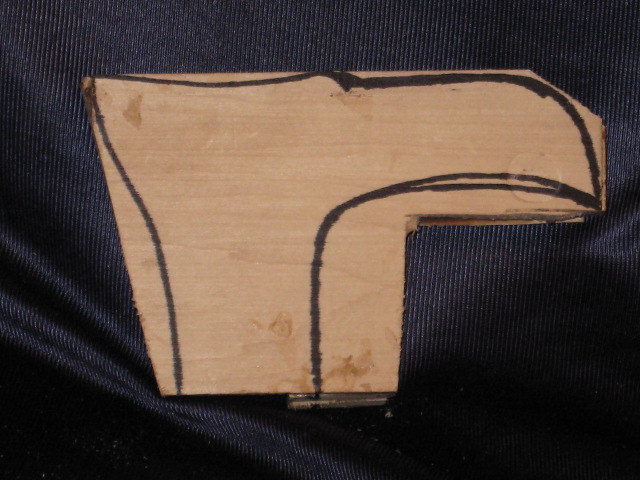
 Attachment: 104.59 KB Attachment: 104.59 KB
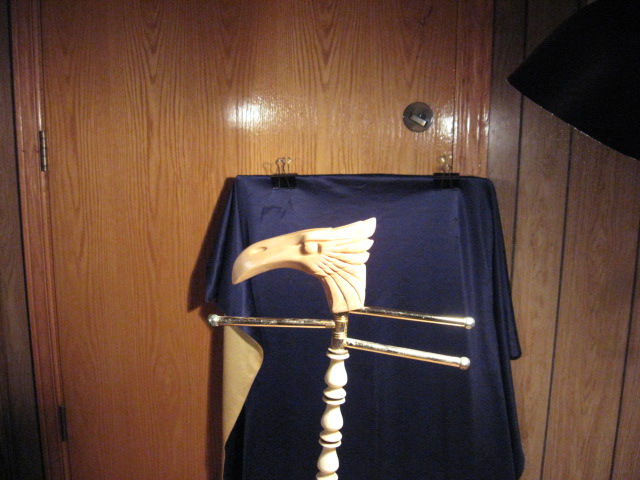
You can easily give up your freedom. You have to fight hard to get it back!
|
|
  |
 |
Leo Todeschini
Industry Professional

|
 Posted: Thu 30 Oct, 2014 1:54 pm Post subject: Posted: Thu 30 Oct, 2014 1:54 pm Post subject: |
 |
|
Hi All,
A great carving Jean, and I guess it should be here any day now, so I will see it in the flesh.
It all sounds very grand, but as Jean says I have a 'division' called Tods Foundry. This is the part of my business where I sell castings. I will be straight up and say I don't actually do any casting here; as much as anything as I don't have the time, although I have thought about getting a casting set up, but haven't yet.
I will start with outlining the lost wax process. Lost wax is a process which the Romans certainly were using and probably predates them, with two principle differences. But I will come to that.
The process involves making a piece in wax, casing it in a shell (a plaster type material), heating it to melt the wax out, then heating it very hot to burn out any residue then pouring in the molten metal whilst the mould is still hot enough to help stop the metal cooling before it has filled the mould.
Historically the waxes were usually individually made, encased and then filled with metal. Though I have seen a mould to make the waxes, so you can be pretty sure they mass produced the waxes too. The main differences now are that the individual waxes are assembled onto a tree. So that you have a main 'trunk' where the metal is poured in. It then passes down 'branches' until it gets to the 'leaves' i.e. the pieces you want to cast. In this way a single pour can cast tens of parts if they are small enough. The second main difference is that many processes now use a vacuum to help quickly draw the metal int the mould. this helps reduce bad/partial casts and improves detail. Thirdly the waxes are made by casting into a rubber mould. Otherwise as I said the process is pretty much the same. I have seen medieval stone buckle moulds that have 8 or 10 buckles carved into a single form so they cast multiples into stone in a single pour, so maybe they did make trees too.
Historically bronzes were cast using lost wax, but iron and steel was too hot for this process. We are now able to cast various steels using the lost wax method.
In my case I use two different foundries for the bronze and steel and due to their different ways of operating it changes how the numbers work.
For bronze they cast the waxes and make up trees of many customers pieces , so in this way I can ask for a single piece, though this is simply annoying for them, so for special occasions I can do this, but I tend to order 5 of a part. The steel foundry sells by the tree and does not cast waxes, so I have to send the finished waxes that I cast here and buy a tree at a time, so I have to ensure I send enough pieces to fill the tree otherwise things rapidly get very expensive.
Because the waxes are cast in rubber moulds, there is no need to worry about 'undercuts' or 'returns' and detail is excellent.
This will likely be a tricky piece to cast, because it contains both very thick and thin parts and usually a higher temperature is used for thin parts to aid flow, but conversely this can cause cracking problems on thicker parts.
Tod
www.todsworkshop.com
www.todcutler.com
www.instagram.com/todsworkshop
https://www.facebook.com/TodsWorkshop
www.youtube.com/user/todsstuff1
|
|
   |
 |
|
Pieter B.
|
 Posted: Thu 30 Oct, 2014 3:24 pm Post subject: Posted: Thu 30 Oct, 2014 3:24 pm Post subject: |
 |
|
|
Hey Tod I do not want to derail this thread, but I would like to thank you for all the video's on crossbows you put up on youtube. I love them and they were really insightful.
|
|
  |
 |
Jean Thibodeau

|
 Posted: Sat 01 Nov, 2014 1:22 pm Post subject: Posted: Sat 01 Nov, 2014 1:22 pm Post subject: |
 |
|
Tod received the sculpture safely on Friday, so my paying extra for a 4 day guarantied delivery by Canada Post/Royal Mail wasn't wasted money. 
Tod will keep me informed when he starts working on it and the " estimated " delivery time is some time before Xmas.
Maybe Tod will chime in from time to time with in progress pics, maybe here or maybe on the " Makers & Manufacturers Forum " where he can promote his work more freely than on this Topic ..... I guess it will depend on if he has the time available, but I certainly sort of " encouraged " him to do " In progress pics " as these are always very interesting Topic thread where we can learn about how things are made.
I have some general knowledge of the lost wax process, but not that much using the latex moulding material used to make a master mould that is then used to make identical copies in wax, that are then used for the lost wax process to make the individual pieces all at once on the casting tree.
But with these things there are always technical details that one doesn't know, and knowing them it makes it easier to understand the limits on the amount of details and complexity one can get with a very detailed sculpture with a lot of undercutting.
Without the modern flexible moulding materials a lot of castings of complex forms would have been a lot harder to do I think.
You can easily give up your freedom. You have to fight hard to get it back!
|
|
  |
 |
Glen A Cleeton

|
 Posted: Sat 01 Nov, 2014 3:43 pm Post subject: Posted: Sat 01 Nov, 2014 3:43 pm Post subject: |
 |
|
I am reminded of a video Kerry Stagmer put up about casting an eagle tree. You can see the tree at about 1:50 in this video.
https://www.youtube.com/watch?v=WR3GEJqu_ag
Nice work Jean. Your eagles are not unlike the totems of the NW native Americans.
Cheers
GC
|
|
  |
 |
Leo Todeschini
Industry Professional

|
 Posted: Mon 10 Nov, 2014 12:43 pm Post subject: Posted: Mon 10 Nov, 2014 12:43 pm Post subject: |
 |
|
Jean Thibodeau wrote | Quote: | | Maybe Tod will chime in from time to time with in progress pics, maybe here or maybe on the " Makers & Manufacturers Forum " where he can promote his work more freely than on this Topic ..... I guess it will depend on if he has the time available, but I certainly sort of " encouraged " him to do " In progress pics " as these are always very interesting Topic thread where we can learn about how things are made. |
I sometime make the wax moulds here, but usually for any steel casting and the moulds for bronze casting are usually made by the foundry, so this has now moved on. I have requested that they take some progress pics during the mould making that I can then post up and talk about, but whether they actually will I can't say - lets hope as it will give us all something more to discuss. In the meantime there is simply going to be a wait.
Jean Thibodeau wrote | Quote: | | Without the modern flexible moulding materials a lot of castings of complex forms would have been a lot harder to do I think. |
Not really more complicated, just harder to mass produce historically as it takes more time. The process is essentially the same as it has ever been in that a wax is encased in a shell, burnt out and then liquid metal poured in. The wax could come from a rubber mould, fully detailed as is the case now, it could be individually carved from scratch (historic and modern) or it could be formed in a two part mould and then details added to the basic shape (historic) or made in one part moulds as shells, welded together and then if required detail added.
Tod
www.todsworkshop.com
www.todcutler.com
www.instagram.com/todsworkshop
https://www.facebook.com/TodsWorkshop
www.youtube.com/user/todsstuff1
|
|
   |
 |
Jean Thibodeau

|
 Posted: Mon 10 Nov, 2014 5:41 pm Post subject: Posted: Mon 10 Nov, 2014 5:41 pm Post subject: |
 |
|
| Leo Todeschini wrote: |
I sometime make the wax moulds here, but usually for any steel casting and the moulds for bronze casting are usually made by the foundry, so this has now moved on. I have requested that they take some progress pics during the mould making that I can then post up and talk about, but whether they actually will I can't say - lets hope as it will give us all something more to discuss. In the meantime there is simply going to be a wait.
Not really more complicated, just harder to mass produce historically as it takes more time. The process is essentially the same as it has ever been in that a wax is encased in a shell, burnt out and then liquid metal poured in. The wax could come from a rubber mould, fully detailed as is the case now, it could be individually carved from scratch (historic and modern) or it could be formed in a two part mould and then details added to the basic shape (historic) or made in one part moulds as shells, welded together and then if required detail added.
Tod |
Well, I'm still very pleased with the feedback and that the process of making the bronzes has started.
Well, as to pics and feedback from Tod, he is just going according to the realities of the process when he doesn't deal personally with making the master mould, waxes and all the rest.
Seeing some of the process done by the foundry would certainly be interesting but mostly just " bonus points " .
I assume that Tod will show some of the things he does to the castings after getting them back from the foundry to clean up the castings.
Without it being said it seems to me to be a good sigh that the wooden model I sent doesn't have any insurmountable problems making casting it too difficult or impossible, so it does inform me that I haven't exceeded any technical limits in the complexity of the wooden model.
We could discuss the variables in making a model for casting and maybe thinking out of the box: I did make it using just one material I was familiar with and sort of still thinking in terms of a good looking finished model.
I'm thinking that one might be able to combine and use a variety of materials and glue them together, and as long as the materials releases properly from the rubber moulding material it doesn't really matter how much " Frankensteinish " it might look as a model made from many different materials: All that really counts is that the shape is accurately transferred to the mould.
As an example I could see using a tube of PVC or metal for a round socket hole and then using it in a square wooden hole and filling the space between the square and the tube with some sort of filler.
Maybe one could also build up a shape with polystyrenes card material and combine it with wooden parts ?
Some kinds of epoxy putty might also be carved etc ...... Basically using the " TIRED " business cliché expression " Thinking out of the Box " and only be concerned with the final shape to be moulded and not with what materials it is put together with ? ( Note the various pieces should be securely assembled so that parts don't fall off during moulding ).
You can easily give up your freedom. You have to fight hard to get it back!
|
|
  |
 |
Jean Thibodeau

|
 Posted: Wed 14 Jan, 2015 2:04 pm Post subject: Posted: Wed 14 Jan, 2015 2:04 pm Post subject: |
 |
|
Well Tod e-mailed me yesterday that he has received the bronzes from the foundry and would soon send me some pics.
If he doesn't have the time to post them here himself I will post them here myself.
After I mount one bronze head onto a stick I'll post that on my walking stick Topic.
Looking forward and very curious to see how they turned out ? I assume that I might have to do some polishing on them but Tod is supposed to remove the sprues and do an initial sating finish clean up.
I have the options to do different things with each head: I could mirror polish one, and maybe leave another one with a sating finish ? I can see possibly adding detail to one using files of a dremel etc ..... a lot will depend on what I decide to do project by project.
I also have the option of ordering more copies as Tod is keeping the master mould but he will be sending back to me the wooden model.
And I also can carve new designs to be made in bronze: Sort of opens up a lot of creative possibilities.
You can easily give up your freedom. You have to fight hard to get it back!
|
|
  |
 |
|
Mike O'Hara
|
 Posted: Wed 14 Jan, 2015 3:06 pm Post subject: Bronzes Posted: Wed 14 Jan, 2015 3:06 pm Post subject: Bronzes |
 |
|
Look forward to seeing the result, Jean. I follow this project of yours with interest
cheers
mike
MIke O'Hara
Location: Plimmerton, New Zealand
|
|
  |
 |
|
Peter Messent
|
 Posted: Wed 14 Jan, 2015 4:27 pm Post subject: Posted: Wed 14 Jan, 2015 4:27 pm Post subject: |
 |
|
Very cool! I've wanted to get bronze done up a few times, but I have no experience in wax carving and wasn't sure how well it would hold up in shipping. I am very familiar with working wood though, so that does open up some possibilities  Look forward to seeing the finished product! Look forward to seeing the finished product!
|
|
  |
 |
Aaron Hoard

|
|
  |
 |
Rim Andries

|
 Posted: Thu 15 Jan, 2015 7:40 am Post subject: Posted: Thu 15 Jan, 2015 7:40 am Post subject: |
 |
|
You are quite the wood wizard Jean! No doubt Tod will be able to turn this into a fine piece.
Sir Dreamin'
|
|
  |
 |
|
Ralph Grinly
|
 Posted: Thu 15 Jan, 2015 12:53 pm Post subject: Posted: Thu 15 Jan, 2015 12:53 pm Post subject: |
 |
|
These look great - and that eagle beak could do some serious damage if the cane was used as a weapon  Just for curiosities sake, what does the head weigh now that is finally cast ? Just for curiosities sake, what does the head weigh now that is finally cast ?
|
|
  |
 |
Jean Thibodeau

|
 Posted: Thu 15 Jan, 2015 10:25 pm Post subject: Posted: Thu 15 Jan, 2015 10:25 pm Post subject: |
 |
|
| Ralph Grinly wrote: | These look great - and that eagle beak could do some serious damage if the cane was used as a weapon  Just for curiosities sake, what does the head weigh now that is finally cast ? Just for curiosities sake, what does the head weigh now that is finally cast ? |
Well, Tod hasn't gotten back to me yet with pics or information about the weight of the bronze head.
I'll give all the information I have as soon as I get it.
Tod is busy getting ready for his being out of town to do some contracted work of some kind, so he may not have had time to get back to me yet.
Well, the beak and the " feathers " on the other side are sort of " mace like " for some odd reason ...... 
You can easily give up your freedom. You have to fight hard to get it back!
|
|
  |
 |
Jean Thibodeau

|
 Posted: Thu 15 Jan, 2015 10:26 pm Post subject: Posted: Thu 15 Jan, 2015 10:26 pm Post subject: |
 |
|
| Rim Andries wrote: | | You are quite the wood wizard Jean! No doubt Tod will be able to turn this into a fine piece. |
Thanks, nice words appreciated. 
You can easily give up your freedom. You have to fight hard to get it back!
|
|
  |
 |
Jean Thibodeau

|
 Posted: Thu 15 Jan, 2015 10:34 pm Post subject: Posted: Thu 15 Jan, 2015 10:34 pm Post subject: |
 |
|
Thanks for the link I'll check it out.
Well I do have an Albion Sovereign and my cinquedea that have bronze pommels and they patinated to a very nice colour naturally: If one doesn't use metal cleaner bronze does age all by itself. with exposure, and maybe skin oils and acids also contribute to patination ?
I guess if one wants to accelerate the process to make the bronze age the way it might take decades or centuries using a chemical method would be the way to go, also certain chemical could give different colours ?
Now I don't think I would want to age it so that it would look like a 3,000 year old piece of bronze.
You can easily give up your freedom. You have to fight hard to get it back!
|
|
  |
 |
Aaron Hoard

|
 Posted: Thu 15 Jan, 2015 11:38 pm Post subject: Posted: Thu 15 Jan, 2015 11:38 pm Post subject: |
 |
|
Depending on what chemicals/process you use, you can get all sorts of colors. For example, here's a bronze box that has an amazing blue color.
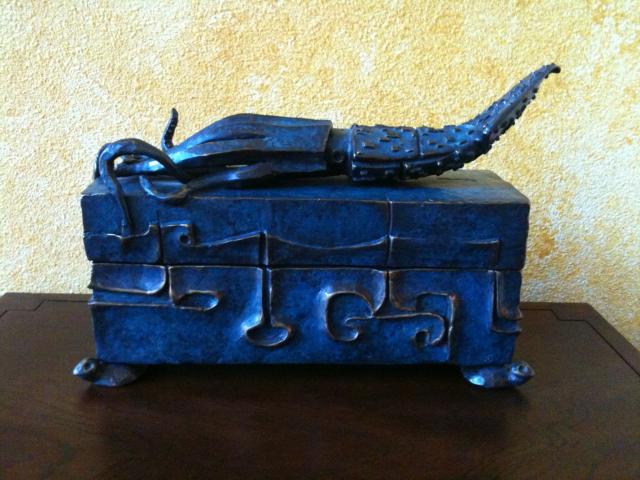
|
|
  |
 |
|
|

